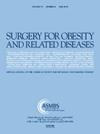Development of venous thromboembolic event risk calculator for metabolic and bariatric surgery patients to reduce mortality
IF 3.5
3区 医学
Q1 SURGERY
引用次数: 0
Abstract
Background
Venous Thromboembolic events (VTE) after Metabolic and Bariatric Surgery (MBS) result in significant morbidity and are the leading cause of mortality.
Objective
The objective of this study was to identify patients who are at a high risk for developing VTE and who may benefit from extended chemoprophylaxis following MBS.
Setting
Multi-institutional study.
Methods
Using the 2015-2019 Metabolic and Bariatric Surgery Accreditation and Quality Improvement Program (MBSAQIP) participant user file (PUF), we identified 696,069 patients who completed 30-day follow-up data and met the inclusion criteria. Using logistic regression analysis, we identified preoperative and postoperative risk factors associated with VTE and validated our model externally using the MBSAQIP 2020-2021 datasets (N = 273,692). The Hosmer–Lemeshow test was used for goodness of fit and calibration. We also compared our model’s discriminatory capability with that of other VTE risk assessment tools. We then used these risk factors to create an online open source application.
Results
The overall incidence of VTE after MBS in the 696,069 (MBSAQIP 2015-2019 database) patients included in our analysis was .40% (2759 patients). Our model had a good predictive capability, with a C-statistic of .66. Our model also demonstrated good fit with a Hosmer–Lemeshow chi-square of 11.06 (P = .198). A cut-off point of .4% resulted in a sensitivity of 48.28%, with 24% of patients having a VTE risk greater than .4% within the 2015-2019 MBSAQIP dataset. Among all the perioperative factors selected in the PUF, high risk for VTE included African American race (adjusted odds ratios [AOR] 1.625, P < .0001), operation length in minutes (AOR: 1.003, P < .0001), preop functional status (AOR 1.012, P = .007), procedure type (Roux en Y Gastric Bypass; AOR .768, P < .0001 and RBS; AOR .758, P = .019 with respect to sleeve), preop body mass index (BMI) (AOR 1.012, P < .001), history of pre-op vein thrombosis requiring therapy (AOR 5.041, P < .0001), post-op superficial or organ space surgical site infection (AOR 2.713, P < .0001), preop venous stasis (AOR 1.425, P = .019),at least one readmission within 30 days(AOR 1.583, P < .0001), or at least one reoperation within 30 days (AOR 4.399, P < .0001).
Conclusion
VTE after MBS can result in increased mortality rates. High-risk patients might benefit from extended chemoprophylaxis. Our model suggests that patients with a VTE risk ≥ .4% in the first 30 days following surgery may benefit from extended chemoprophylaxis.
开发用于代谢和减肥手术患者的静脉血栓栓塞事件风险计算器以降低死亡率。
背景:代谢和减肥手术(MBS)后静脉血栓栓塞事件(VTE)导致显著的发病率和死亡率的主要原因。目的:本研究的目的是确定发生静脉血栓栓塞(VTE)的高风险患者,以及可能受益于MBS后延长化学预防的患者。环境:多机构研究。方法:使用2015-2019年代谢和减肥手术认证和质量改进计划(MBSAQIP)参与者用户文件(PUF),我们确定了696,069名完成30天随访数据并符合纳入标准的患者。通过logistic回归分析,我们确定了与静脉血栓栓塞相关的术前和术后危险因素,并使用MBSAQIP 2020-2021数据集(N = 273,692)外部验证了我们的模型。采用Hosmer-Lemeshow检验进行拟合优度和校正。我们还比较了我们的模型与其他静脉血栓栓塞风险评估工具的区分能力。然后,我们使用这些风险因素来创建一个在线开源应用程序。结果:纳入我们分析的696,069例(MBSAQIP 2015-2019数据库)患者中,MBS术后静脉血栓栓塞的总发生率为0.40%(2759例)。我们的模型具有良好的预测能力,c统计量为0.66。我们的模型也显示出良好的拟合,Hosmer-Lemeshow卡方为11.06 (P = .198)。截断点为0.4%,敏感性为48.28%,在2015-2019年MBSAQIP数据集中,24%的患者静脉血栓栓塞风险大于0.4%。在PUF选择的所有围手术期因素中,静脉血栓栓塞的高危因素包括非裔美国人种族(调整优势比[AOR] 1.625, P < 0.0001)、手术时间(AOR: 1.003, P < 0.0001)、术前功能状态(AOR: 1.012, P = 0.007)、手术类型(Roux en Y胃旁路术;AOR = 768, P < 0.0001;AOR 0.758, P = 0.019(相对于袖),术前体重指数(BMI) (AOR 1.012, P < 0.001),术前静脉血栓形成史需要治疗(AOR 5.041, P < 0.0001),术后浅表或器官间隙手术部位感染(AOR 2.713, P < 0.0001),术前静脉淤积(AOR 1.425, P = 0.019), 30天内至少一次再入院(AOR 1.583, P < 0.0001),或30天内至少一次再手术(AOR 4.399, P < 0.0001)。结论:MBS术后静脉血栓栓塞可导致死亡率增高。高风险患者可能受益于延长化学预防。我们的模型表明,在手术后30天内静脉血栓栓塞风险≥0.4%的患者可能受益于延长的化学预防。
本文章由计算机程序翻译,如有差异,请以英文原文为准。
求助全文
约1分钟内获得全文
求助全文
来源期刊
CiteScore
6.70
自引率
12.90%
发文量
570
审稿时长
56 days
期刊介绍:
Surgery for Obesity and Related Diseases (SOARD), The Official Journal of the American Society for Metabolic and Bariatric Surgery (ASMBS) and the Brazilian Society for Bariatric Surgery, is an international journal devoted to the publication of peer-reviewed manuscripts of the highest quality with objective data regarding techniques for the treatment of severe obesity. Articles document the effects of surgically induced weight loss on obesity physiological, psychiatric and social co-morbidities.

 求助内容:
求助内容: 应助结果提醒方式:
应助结果提醒方式:


